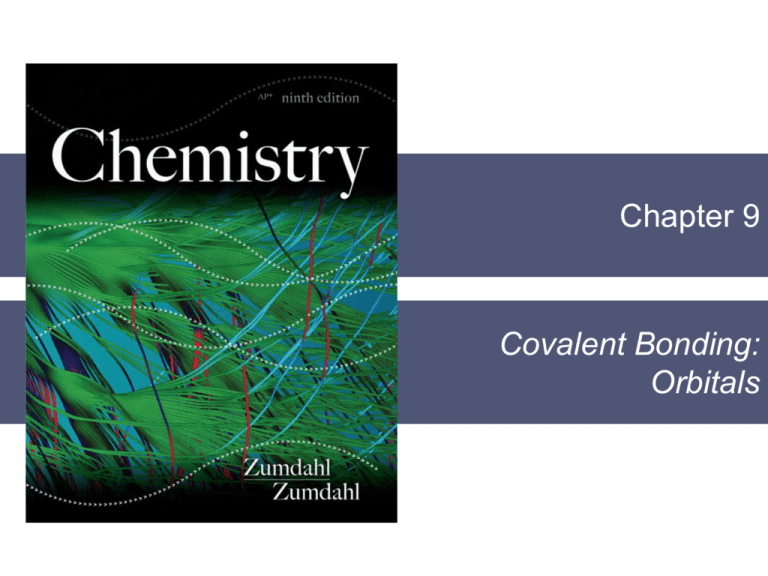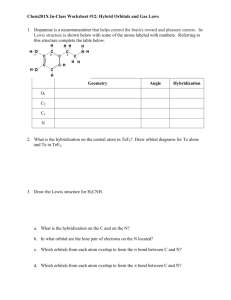
AP*
Chapter 9
Covalent Bonding:
Orbitals
AP Learning Objectives
LO 1.7 The student is able to describe the electron structure of the atom, using
PES (photoelectron spectroscopy) data, ionization energy data, and/or
Coulomb’s Law to construct explanations of how the energies of electrons
within shells in atoms vary. (Sec 9.6)
LO 1.15 The student can justify the selection of a particular type of spectroscopy
to measure properties associated with vibrational or electronic motions of
molecules. (Sec 9.6)
LO 2.18 The student is able to rank and justify the ranking of bond polarity on
the basis of the locations of the bonded atoms in the periodic table. (Sec 9.4)
LO 2.21 The student is able to use Lewis diagrams and VSEPR to predict the
geometry of molecules, identify hybridization, and make predictions about
polarity. (Sec 9.1, 9.6)
Section 9.1
Hybridization and the Localized Electron Model
AP Learning Objectives, Margin Notes and References
Learning Objectives
LO 2.21 The student is able to use Lewis diagrams and VSEPR to predict the geometry of molecules, identify
hybridization, and make predictions about polarity.
Section 9.1
Hybridization and the Localized Electron Model
EXERCISE!
Draw the Lewis structure for methane, CH4.
What is the shape of a methane molecule?
tetrahedral
What are the bond angles?
109.5o
H
H C H
H
Copyright © Cengage Learning. All rights reserved
4
Section 9.1
Hybridization and the Localized Electron Model
CONCEPT CHECK!
What is the valence electron configuration of a
carbon atom?
s2p2
Why can’t the bonding orbitals for methane be
formed by an overlap of atomic orbitals?
Copyright © Cengage Learning. All rights reserved
5
Section 9.1
Hybridization and the Localized Electron Model
Bonding in Methane
Assume that the carbon atom has four equivalent
atomic orbitals, arranged tetrahedrally.
Copyright © Cengage Learning. All rights reserved
6
Section 9.1
Hybridization and the Localized Electron Model
Hybridization
Mixing of the native atomic orbitals to form special
orbitals for bonding.
Copyright © Cengage Learning. All rights reserved
7
Section 9.1
Hybridization and the Localized Electron Model
sp3 Hybridization
Combination of one s and three p orbitals.
Whenever a set of equivalent tetrahedral atomic
orbitals is required by an atom, the localized electron
model assumes that the atom adopts a set of sp3
orbitals; the atom becomes sp3 hybridized.
The four orbitals are identical in shape.
Copyright © Cengage Learning. All rights reserved
8
Section 9.1
Hybridization and the Localized Electron Model
An Energy-Level Diagram Showing the Formation of
Four sp3 Orbitals
Copyright © Cengage Learning. All rights reserved
9
Section 9.1
Hybridization and the Localized Electron Model
The Formation of sp3 Hybrid Orbitals
Copyright © Cengage Learning. All rights reserved
10
Section 9.1
Hybridization and the Localized Electron Model
Tetrahedral Set of Four sp3 Orbitals
Copyright © Cengage Learning. All rights reserved
11
Section 9.1
Hybridization and the Localized Electron Model
EXERCISE!
Draw the Lewis structure for C2H4 (ethylene)?
What is the shape of an ethylene molecule?
trigonal planar around each carbon atom
What are the approximate bond angles around the
carbon atoms?
120o
H
H
H
Copyright © Cengage Learning. All rights reserved
C C
12
H
Section 9.1
Hybridization and the Localized Electron Model
CONCEPT CHECK!
Why can’t sp3 hybridization account for the
ethylene molecule?
Copyright © Cengage Learning. All rights reserved
13
Section 9.1
Hybridization and the Localized Electron Model
sp2 Hybridization
Combination of one s and two p orbitals.
Gives a trigonal planar arrangement of atomic
orbitals.
One p orbital is not used.
Oriented perpendicular to the plane of the sp2
orbitals.
Copyright © Cengage Learning. All rights reserved
14
Section 9.1
Hybridization and the Localized Electron Model
Sigma (Σ) Bond
Electron pair is shared in an area centered on a line
running between the atoms.
Copyright © Cengage Learning. All rights reserved
15
Section 9.1
Hybridization and the Localized Electron Model
Pi (Π) Bond
Forms double and triple bonds by sharing electron
pair(s) in the space above and below the σ bond.
Uses the unhybridized p orbitals.
Copyright © Cengage Learning. All rights reserved
16
Section 9.1
Hybridization and the Localized Electron Model
An Orbital Energy-Level Diagram for sp2 Hybridization
Copyright © Cengage Learning. All rights reserved
17
Section 9.1
Hybridization and the Localized Electron Model
The Hybridization of the s, px, and py Atomic Orbitals
Copyright © Cengage Learning. All rights reserved
18
Section 9.1
Hybridization and the Localized Electron Model
Formation of C=C Double Bond in Ethylene
To play movie you must be in Slide Show Mode
PC Users: Please wait for content to load, then click to play
Mac Users: CLICK HERE
Copyright © Cengage Learning. All rights reserved
19
Section 9.1
Hybridization and the Localized Electron Model
EXERCISE!
Draw the Lewis structure for CO2.
What is the shape of a carbon dioxide molecule?
linear
What are the bond angles?
180o
O C O
Copyright © Cengage Learning. All rights reserved
20
Section 9.1
Hybridization and the Localized Electron Model
sp Hybridization
Combination of one s and one p orbital.
Gives a linear arrangement of atomic orbitals.
Two p orbitals are not used.
Needed to form the π bonds.
Copyright © Cengage Learning. All rights reserved
21
Section 9.1
Hybridization and the Localized Electron Model
The Orbital Energy-Level Diagram for the Formation of sp
Hybrid Orbitals on Carbon
Copyright © Cengage Learning. All rights reserved
22
Section 9.1
Hybridization and the Localized Electron Model
When One s Orbital and One p Orbital are Hybridized, a Set of Two sp
Orbitals Oriented at 180 Degrees Results
Copyright © Cengage Learning. All rights reserved
23
Section 9.1
Hybridization and the Localized Electron Model
The Orbitals for CO2
Copyright © Cengage Learning. All rights reserved
24
Section 9.1
Hybridization and the Localized Electron Model
EXERCISE!
Draw the Lewis structure for PCl5.
What is the shape of a phosphorus pentachloride
molecule?
trigonal bipyramidal
What are the bond angles?
Cl Cl
o
o
90 and 120
Cl
P
Cl
Copyright © Cengage Learning. All rights reserved
25
Cl
Section 9.1
Hybridization and the Localized Electron Model
dsp3 Hybridization
Combination of one d, one s, and three p orbitals.
Gives a trigonal bipyramidal arrangement of five
equivalent hybrid orbitals.
Copyright © Cengage Learning. All rights reserved
26
Section 9.1
Hybridization and the Localized Electron Model
The Orbitals Used to Form the Bonds in PCl5
Copyright © Cengage Learning. All rights reserved
27
Section 9.1
Hybridization and the Localized Electron Model
EXERCISE!
Draw the Lewis structure for XeF4.
What is the shape of a xenon tetrafluoride
molecule?
octahedral
What are the bond angles?
F
90o and 180o
F Xe
F
Copyright © Cengage Learning. All rights reserved
28
F
Section 9.1
Hybridization and the Localized Electron Model
d2sp3 Hybridization
Combination of two d, one s, and three p orbitals.
Gives an octahedral arrangement of six equivalent
hybrid orbitals.
Copyright © Cengage Learning. All rights reserved
29
Section 9.1
Hybridization and the Localized Electron Model
How is the Xenon Atom in XeF4 Hybridized?
Copyright © Cengage Learning. All rights reserved
30
Section 9.1
Hybridization and the Localized Electron Model
CONCEPT CHECK!
Draw the Lewis structure for HCN.
Which hybrid orbitals are used?
Draw HCN:
Showing all bonds between atoms.
Labeling each bond as σ or π.
Copyright © Cengage Learning. All rights reserved
31
Section 9.1
Hybridization and the Localized Electron Model
CONCEPT CHECK!
Determine the bond angle and expected
hybridization of the central atom for each of the
following molecules:
NH3
SO2
KrF2
CO2
ICl5
NH3 – 109.5o, sp3
SO2 – 120o, sp2
KrF2 – 90o, 120o, dsp3
CO2 – 180o, sp
ICl5 – 90o, 180o, d2sp3
Section 9.1
Hybridization and the Localized Electron Model
Using the Localized Electron Model
Draw the Lewis structure(s).
Determine the arrangement of electron pairs using
the VSEPR model.
Specify the hybrid orbitals needed to accommodate
the electron pairs.
Copyright © Cengage Learning. All rights reserved
33
Section 9.4
Bonding in Heteronuclear Diatomic Molecules
AP Learning Objectives, Margin Notes and References
Learning Objectives
LO 2.18 The student is able to rank and justify the ranking of bond polarity on the basis of the locations of the
bonded atoms in the periodic table.
Section 9.4
Bonding in Heteronuclear Diatomic Molecules
Heteronuclear Diatomic Molecules
Composed of 2 different atoms.
Copyright © Cengage Learning. All rights reserved
35
Section 9.4
Bonding in Heteronuclear Diatomic Molecules
Heteronuclear Diatomic Molecule: HF
The 2p orbital of fluorine is at a lower energy than the 1s
orbital of hydrogen because fluorine binds its valence
electrons more tightly.
Electrons prefer to be closer to the fluorine atom.
Thus the 2p electron on a free fluorine atom is at a lower
energy than the 1s electron on a free hydrogen atom.
Copyright © Cengage Learning. All rights reserved
36
Section 9.4
Bonding in Heteronuclear Diatomic Molecules
Orbital Energy-Level Diagram for the HF Molecule
Copyright © Cengage Learning. All rights reserved
37
Section 9.4
Bonding in Heteronuclear Diatomic Molecules
Heteronuclear Diatomic Molecule: HF
The diagram predicts that the HF molecule should be
stable because both electrons are lowered in energy
relative to their energy in the free hydrogen and fluorine
atoms, which is the driving force for bond formation.
Copyright © Cengage Learning. All rights reserved
38
Section 9.4
Bonding in Heteronuclear Diatomic Molecules
The Electron Probability Distribution in the Bonding Molecular Orbital
of the HF Molecule
Copyright © Cengage Learning. All rights reserved
39
Section 9.4
Bonding in Heteronuclear Diatomic Molecules
Heteronuclear Diatomic Molecule: HF
The σ molecular orbital containing the bonding electron
pair shows greater electron probability close to the
fluorine.
The electron pair is not shared equally.
This causes the fluorine atom to have a slight excess of
negative charge and leaves the hydrogen atom partially
positive.
This is exactly the bond polarity observed for HF.
Copyright © Cengage Learning. All rights reserved
40
Section 9.6
Photoelectron Spectroscopy (PES)
AP Learning Objectives, Margin Notes and References
Learning Objectives
LO 1.7 The student is able to describe the electron structure of the atom, using PES (photoelectron spectroscopy)
data, ionization energy data, and/or Coulomb’s Law to construct explanations of how the energies of electrons
within shells in atoms vary.
LO 1.15 The student can justify the selection of a particular type of spectroscopy to measure properties associated
with vibrational or electronic motions of molecules.
LO 2.21 The student is able to use Lewis diagrams and VSEPR to predict the geometry of molecules, identify
hybridization, and make predictions about polarity.
Additional AP References
LO 1.15 (see APEC #1 “Energy Levels and Electron Transitions”)
LO 1.15 (see Appendix 7.4 “Molecular Spectroscopy: An Introduction”)
Section 9.6
Photoelectron Spectroscopy (PES)
Can be used to determine the relative energies of
electrons in individual atoms and molecules.
High-energy photons are directed at the sample, and
the kinetic energies of the ejected electrons are
measured.
Copyright © Cengage Learning. All rights reserved
42






